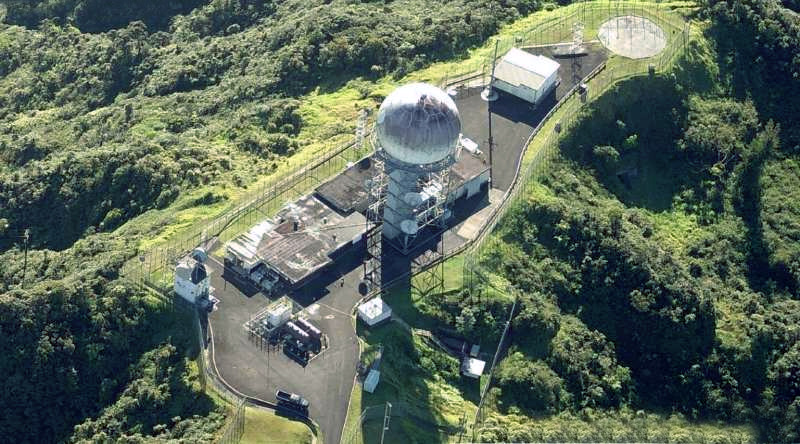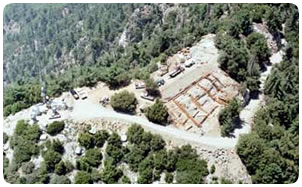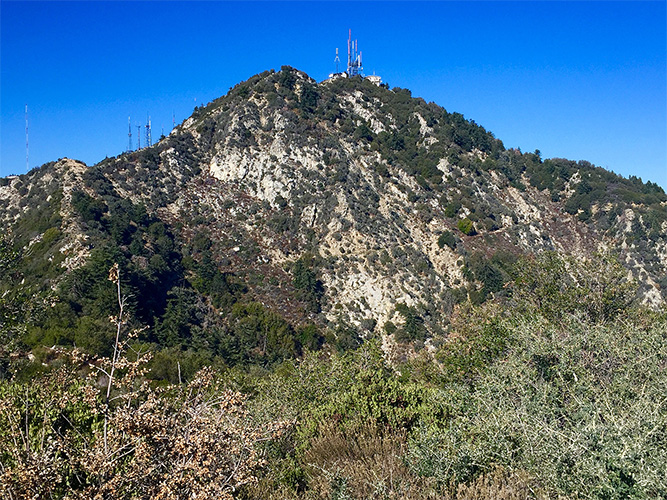Remote Mountain Top Concrete Construction Projects
The following project descriptions are examples of remote mountain top areas that were challenging and yet completed to specs, on time and within budget by the George L. Throop Company.
Mountain Top Concrete Production at Mount Kaala, Hawaii

The Throop Company was doing a lighting upgrade at the San Diego Airport when a representative from Raytheon asked if we would be interested in doing a foundation at the highest point in Hawaii. We said, “Absolutely!” Luckily the contractor we were working with also said they were interested as well and we both got the job.
In Hawaii the local ready mix company was not set up to service a remote mountain top project such as this due to the time and distance away from the ready mix plant, the steepness of the road and the time needed to be on the road for the day of the pour, etc.
When we were working, there were some days we were in fog because of the altitude. Other days the clouds were below us. Besides the challenge of getting our equipment up the narrow mountain road, we had to deal with temperature and moisture changes all the time.
When the contractor began digging the area to build the foundation, they found an existing foundation. With all of the deadlines that went into the 24/7 operation, to have to remove an existing foundation with all of the rebar and anchor bolts did not help. But it got done.
The specs for this mountain top concrete project were for a 40’ x 40’ x 5’ thick foundation.
Due to the thickness of the slab, thermocouples had to be installed in the center and at the surface of the slab to record temperatures. As soon as it was possible a 10” layer of Class 2 base was placed over the surface to act as insulation. It couldn’t be over a 30 degree difference between the center of the slab and the outside surface temperature or else internal cracking would occur.
There were very stringent location criteria for the anchor bolts. A surveyor was present to validate the 2” plus diameter anchor bolts did not move during the concrete placements. Some anchors were over 60’ away.
The Throop Company decided to use two pumps, a trailer pump and a boom pump, to place the concrete in order to insure that the timing of the placement was just right. The trailer pump was used to pump the concrete through the system of the boom pump bypassing the actual pump on the boom pump. The operator of the boom pump was local in Hawaii. He was whining big time because his remote control would not work due to all of the radar equipment at the location. He had to climb up and use the hydraulic handles manually to move the boom during the placing of the concrete.
The project was very successful for everyone involved. After driving back down the mountain we took our equipment back to the harbor to be shipped back to Los Angeles.
Mt. Harvard Lodestar Tower (near Mt. Wilson in Southern California), San Gabriel Mountains, California

View the photo that shows the beginning stage of the 10,000 sq ft building foundation. Please note the slope of the forms on the hill. Lower forms were 35 feet below the level of the concrete production site. It was a challenge we were able to handle.
In the summer of 2000, we were hired to be the ready-mix producer for a very remote and mountainous construction job. Because of its remote location, using regular ready-mix truck transportation was not feasible; they would be unable to drive the small windy road. From the City of La Canada, it takes about 1.5 hours to reach the construction site, part of which had very mountainous roads. The job was to construct a new 200 ft. communications tower with broadcasting and wireless technology capabilities for the Lodestar Towers Company. In addition to the tower, a 10,000 sq. ft., two story concrete building, was required to be built. Due to the remote construction site, extensive excavation and structural design was required which the Throop Company participated in. Some of the challenges included significant coordination among the different organizations including updating and reinforcing the road in order to move equipment in and out.

There were various mix designs that were required for the job. One concrete mix design included a shrinkage-reducing admixture, called Tetraguard by Masterbuilders. Because of the addition of Tetraguard, we were able to use 3/8″ rock as coarse aggregate for the foundation, flatwork, and roof slab. Shrinkage tests were comparable to using 1″ rock. Tetraguard allowed the placement to take place with a 2.5″ hose whereas it would normally have taken a 4″ concrete pump hose. A boom pump could not be utilized because of lack of access. Our on-site concrete plant, though, was able to produce over a total of 1,000 cubic yards. The various concrete mix designs we produced included masonry grout, shotcrete, flowable fill, and shrinkage compensating concrete.
The photo to the right is a view of the concrete being produced and placed for the communications tower foundation. Note that the building foundation is complete – ready for concrete block. Also note the yellow skiploader loading mixing plant (center of photo). White supersacks containing concrete mix materials also were used to form bunker for bulk sand. Our concrete mixing plant was able to produce 30 cubic yards per hour.
The George L. Throop Company was able to complete the project on time and within budget.

Have a question?


